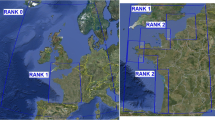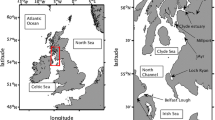Summary
In this paper it is shown that external surges in the North Sea can be generated not only by westerly winds over the continental shelf near Scotland, but also by air pressure gradients near the transition zone of deep to shallow water. The importance of the latter effect, which has been neglected in the literature so far, is illustrated by some cases with an external surge and also by the Hamburg surge of 16 February 1962, which appeared to be accompanied by a rather important external component.
Zusammenfassung
In dieser Arbeit wird gezeigt, daß Fernwellen in der Nordsee nicht nur durch westliche Winde über dem Festlandsockel in der Nähe Schottlands entstehen können, sondern auch durch Luftdruck-Gradienten in der Nähe der Übergangszone vom tiefen zum flachen Wasser. Der Einfluß, den der Luftdruck-Gradient hierbei hat, fand in der Literatur bisher keine Beachtung. Seine Bedeutung wird anhand einiger Fälle erläutert, in denen Fernwellen beobachtet wurden. Auch die Hamburger Sturmflut vom 16. Februar 1962 wird erörtert, zu der eine Fernwelle einen ziemlich bedeutenden Beitrag lieferte.
Résumé
Dans cet article, il est montré que des surélévations d'origine externe en mer du Nord peuvent être engendrées non seulement par les vents d'Ouest au-dessus du plateau continental près de l'Ecosse, mais aussi par des gradients de pression atmosphérique près de la zone de transition entre les eaux profondes et peu profondes. L'importance de ce dernier effet, qui a été négligée jusqu'à présent par les auteurs, est illustrée par quelques cas présentant une onde externe et aussi par la surélévation enregistrée à Hambourg le 16 février 1962, qui se révéla être accompagnée d'une composante externe assez importante.
Similar content being viewed by others
Abbreviations
- b :
-
ratio between scalar values of friction force and wind velocity
- c :
-
b cos β
- C d :
-
drag coefficient
- f :
-
2 ω sin φ, coriolis parameter
- g :
-
gravity
- G :
-
ϱ−1 gradp (gradp=horizontal pressure gradient)
- G x,G y :
-
x andy component ofG
- h :
-
height of the sea surface with respect to an average undisturbed sea surface
- H :
-
depth of the sea
- l :
-
f+b sin β
- p(h) :
-
air pressure at the sea surface
- r :
-
coefficient for the bottom friction
- t :
-
time
- T a :
-
air temperature
- T s :
-
sea surface temperature
- u, v :
-
x andy component of the velocity of a water particle
- U :
-
\(\int\limits_{ - H}^h {u d z} \)
- V :
-
\(\int\limits_{ - H}^h {v d z} \)
- v :
-
wind velocity
- v x,v y :
-
x andy component ofv
- x, y :
-
horizontal Cartesian coordinates,y parallel to the meridian of 22 degrees East
- z :
-
vertical coordinate
- β:
-
angle between friction force and −v
- ϱ:
-
density of the air
- ϱs :
-
density of the sea water
References
Bijvoet, H. C., 1957: A new overlay for the determination of the surface wind over sea from surface weather charts. Meded. Verh. K. ned. met. Inst. Nr. 71.
Corkan, R. H., 1948: Storm surges in the North Sea. Vol. 1, 2. U. S. Hydrogr. Off. Misc. 15702.
Hansen, W., 1966: The reproduction of the motion in the sea by means of hydrodynamical-numerical methods. Mitt. Inst. Meereskd. Univ. Hamburg. Nr. 5.
Heaps, N. S., 1969: A two-dimensional numerical sea model. Philos. Trans. r. Soc. (A)265, 93.
Hesselberg, T., 1915: Über eine Beziehung zwischen Druckgradient, Wind und Gradientänderungen. Veröff. Geophys. Inst. Univ. Leipzig, Ser. 2.1, 207.
Houwen, P. J. van der 1966: On the stability of a difference scheme for the North Sea problem. Rep. TW 100, Mathematisch Centrum, Amsterdam.
Koopmann, G., 1963: Schwallerscheinungen am 16./17. Oktober 1963 in der Deutschen Bucht. Dt. hydrogr. Z.16, 231.
Lauwerier, H. A. and B. R. Damsté, 1963: The North Sea problem, 8. A numerical treatment. Proc. K. ned. Akad. Wet. A66, 167.
Rossiter, J. R., 1958: Storm surges in the North Sea 11 to 30 December 1954. Philos. Trans. r. Soc. (A)251, 139.
Rossiter, J. R., 1959: Research on methods of forecasting storm surges on the east and south coasts of Great Britain. Quart. J. R. met. Soc.85, 262.
Schmitz, H. P., 1962: On external surges and special meteoro-hydrographical problems in computing storm surges in adjacent seas and lakes by physical methods. Mitt. Inst. Meereskd. Univ. Hamburg, Nr. 1; Proc. Symp. Mathem.-hydrodyn. meth. phys. oceanogr. pp. 89.
Schmitz, 1965: Modellrechnungen zur deepwater-surge-Entwicklung — das external surge problem. Dt. hydrogr. Z.18, 49.
Author information
Authors and Affiliations
Electronic supplementary material
Rights and permissions
About this article
Cite this article
Timmerman, H. On the importance of atmospheric pressure gradients for the generation of external surges in the North Sea. Deutsche Hydrographische Zeitschrift 28, 62–71 (1975). https://doi.org/10.1007/BF02232250
Received:
Published:
Issue Date:
DOI: https://doi.org/10.1007/BF02232250




